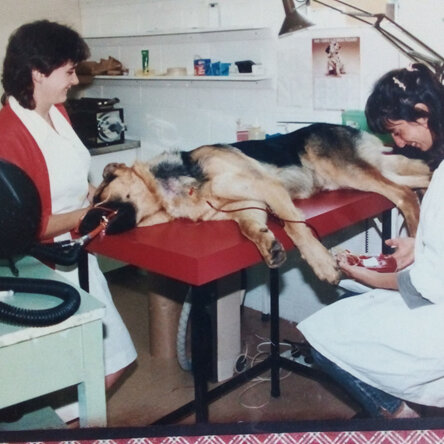Franklin Vets is celebrating its 80th anniversary in 2024 and that creates an opportunity to reflect on some of the ways veterinary care for our pets has changed in that time. No one currently working for Franklin Vets has been here since the practice started 80 years ago, but we do have employees who have been with us for 40 years plus.
Putting aside how the business has grown and changed over the last 40 years, there are some significant changes in how we provide veterinary care for our patients and clients, including new drugs, new technologies and changes to how we do things. Some examples include:
- In 1980 the government used to pay for all laboratory testing on our cats and dogs. Samples were sent to Ruakura Animal Health Lab in Hamilton and it took a few days wait to get results. This changed in the early 80s to user pays, giving pet owners a rather rude awakening to the actual cost of these services. Nowadays most laboratory testing is done in clinic with our own lab machines and with almost immediate results.
- We didn’t have access to computerised records until after 2000. Prior to that everything was done manually using paper records, and correspondence and reminders to clients were done by mail as well.
- There were no instruments for monitoring patients while they were anaesthetised. Animals were invisible under surgical drapes and the only way we knew they were still alive was that we could see the drapes moving as they breathed. These days anaesthetised animals are connected to several types of complex monitors checking their heart with an electrocardiogram, blood oxygen levels, blood pressure, body temperature etc. These days we also keep detailed anaesthetic records noting how those measures have changed during the time under anaesthetic.
- Safety of our patients while anaesthetised has improved a lot for other reasons as well. We now use precision anaesthetic gas machines which are temperature compensated to deliver safe and consistent gas concentrations. In 1980 our old Stephens Vaporiser anaesthetic machine was little more than a glass jar containing anaesthetic liquid which evaporated anaesthetic vapour into the oxygen being piped to the patient. This provided inconsistent and unreliable anaesthetic concentrations. On cold mornings the nurse would have to cup the jar in her hands to warm up the anaesthetic liquid to aid evaporation. Anaesthesia really was more art than science at that time.
- Thinking has changed about pain management especially pain associated with surgery. The commonly held belief in the 1980s was that painkillers were not needed in animals after surgery and that they could potentially be counter-productive. If we took the pain away the animal would be more active and that would increase the risk of wound complications. For a long time now that thinking has been proven wrong. Evidence has shown that pain creates stress which actually slows healing and increases the risk of post-operative problems. The accepted practice these days is that we have an obligation to provide pain relief after surgery, as well as in any situation where pain might be experienced by our patients.
- There were no specialist referral services in Auckland in 1980. If cats and dogs developed complex surgical or medical problems that needed specialist care the only option owners had was to drive or fly with their pets to Massey University Vet School in Palmerston North. Nowadays in Auckland we are lucky to have a number of specialist referral practices available covering surgery, medicine, ophthalmology, dermatology and advanced cancer treatments.
- While all of our clinics did have an xray machine there were no ultrasound machines available for pets and CT and MRI were not even available for humans. Nowadays ultrasound is readily available and the more advanced imaging options are available through specialist practices.
- While a lot of the drugs we used in the early 80s are still available and used today there are lots of new drugs and treatments providing much safer and more effective options for providing pain relief; controlling allergic dermatitis; treating infections; and anaesthetics and sedatives. We also have some easier ways of medicating patients now with some drugs being able to be applied topically onto skin rather than in tablet form, and palatable pastes instead of nasty tasting tablets.
- Flea treatments have also improved a lot. Back then we used to bathe dogs in organophosphate chemicals such as Asuntol and Maldison. Flea collars also contained the same potentially toxic chemicals and weren’t very effective. These treatments were as dangerous to the pets and owners as they were to the fleas. The newer treatments available today have had rigorous safety testing and are proven safe and effective and they last for significantly longer times. Fleas haven’t gone away but are easier to manage.
Times have certainly changed, and we can all rejoice that veterinary science has progressed giving us confidence to be able offer much safer and more effective treatments and solutions for our family pets.
Dr Nick Twyford, BVSc MANZCVS (Medicine of Dogs)
